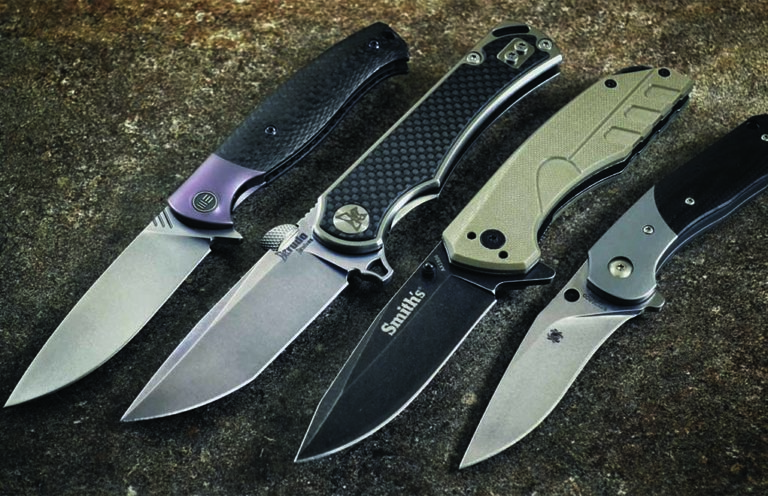
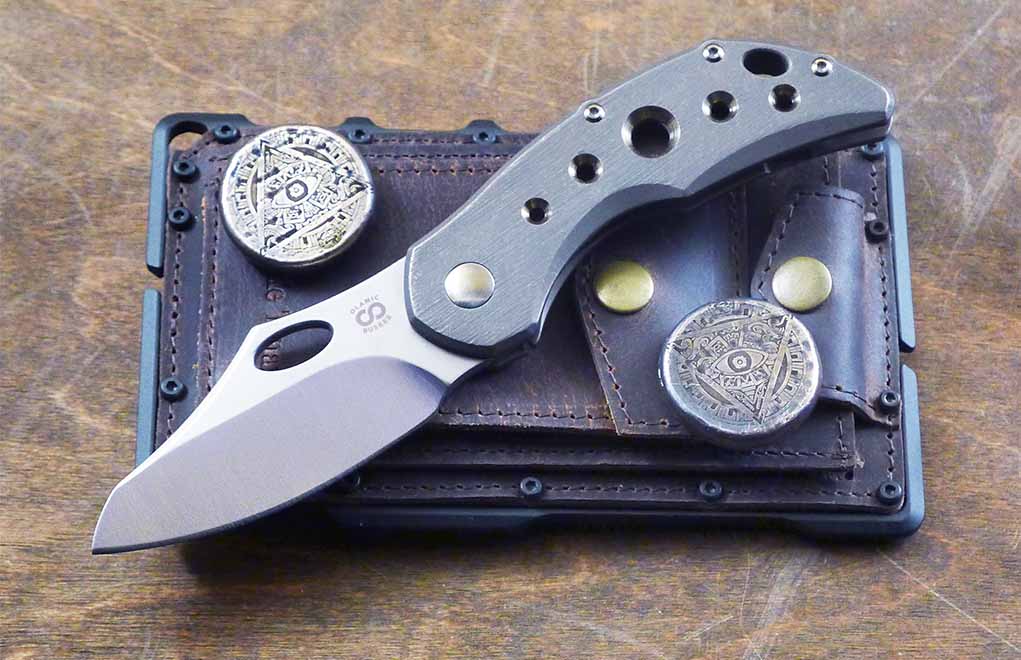
A vital tool and necessary companion to your concealed carry gun, you should never get caught without a knife. Yet, how does one go about choosing the best EDC knife?
What Are The Best EDC Knife Options:
- Olamic Busker Semper
- DPx Urban Ti
- Benchmade Phaeton Auto
- Spyderco Shaman
- A.G. Russell Wharncliffe
- Krudo Karsino10
- Smith’s Battleplan
- Spyderco Hanan
- WE Knife Co. Deacon
The gulf between expensive, high-end knives and affordable, good-quality knives is wide. Some knife users are aghast that anyone would pay $500 for a knife, while others stand in line to get them. Others are perfectly happy with a $50 blade to meet their everyday needs, and the market for these is voluminous. Here we explore the differences between a $500 tactical, EDC knife and a $50 one.
I chose to compare two very successful folding knives, one in each cost category. On the top end is Chris Reeve Knives’ Inkosi, which (with black Micarta inserts) retails for $515. Reeve’s Blade Show awards for “Quality in Manufacturing” over the past 2 decades are unparalleled. We’ll compare the Inkosi to one of Kershaw’s hottest sellers, the Eris, which checks in at $49.99. Both folders are of integral lock (also referred to as frame-lock) design and represent their price group well. There is no winner or loser here.

Larry Connelley is the founder of Knifeart.com, one of the premier Internet sites for selling high-end knives — both custom and production. Connelley started Knifeart.com over 20 years ago and is very knowledgeable about what goes into the production of a knife. I asked Connelley his basic thoughts on why some knives cost more than others.
“The price of a knife is determined by two key factors: labor costs and price of materials,” he said. “The price of higher-end knives is directly related to these factors. The importance of precision in the design of a knife cannot be overstated. High-quality American-made knives are usually produced by skilled manufacturers with a high attention to detail.
“The cost and quality of materials is a major factor in the final price to the consumer,” Connelley added. “While the steel used for the blade and handle are major considerations, all of the other parts — such as the pivot, bushings and spacers — are just as important. All of the enhancements to materials used, along with not cutting corners on manufacturing, provides a superior product.”
Material Matters Most
Before a knife goes into production, the manufacturer must choose the materials that will go into making the blade, handle and component parts. As Connelley noted, on a folding knife the choice of blade steel and frame alloy are the two most important factors in determining the cost and retail price of a knife. Most high-end folding knives have frames made of titanium, while their low-budget counterparts utilize aluminum or stainless-steel for cost savings.
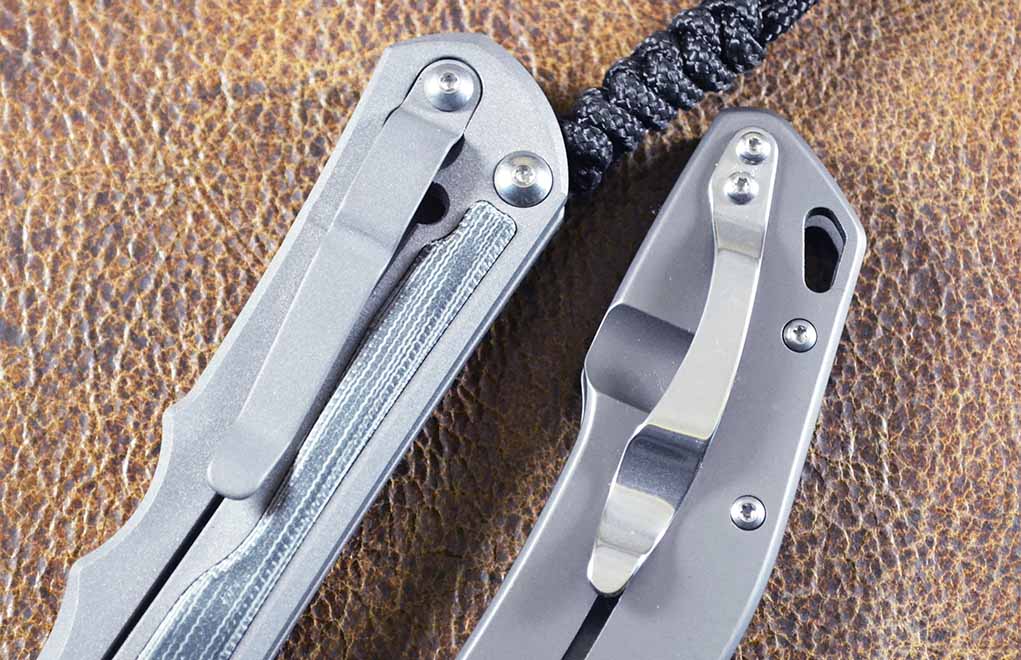
“In general, the material chosen to construct a knife’s handle is indicative of its overall quality,” Connelley notes. “The materials selected to construct a knife handle helps to determine the weight and the strength of the knife itself. While the use of high-quality base materials raises the cost to the consumer, the use of high-quality handle materials will prolong the life of a knife.
Titanium or carbon-fiber are frequently used in the construction of high-quality knives — they’re very strong yet much lighter. If I can choose a stronger yet lighter knife, I will make that selection every time. Heavy doesn’t equal quality.”
Titanium, as Connelley explained, has greater strength and withstands wear and tear better than less costly materials like stainless-steel, polymers or aluminum. The increased cost of titanium comes from longer machining times, thus greater machine shop costs.
The same goes for blade steels, which can easily drive the price of a knife higher. The modern tactical knife boom of the 1990s, spurred on by our country’s involvement in the Gulf Wars, created a demand for higher-grade steels (such as ATS-34 and BG-42 stainless). The blade steel equation got kicked up several notches with the development of S30V stainless, a proprietary powdered knife steel developed by Crucible Industries, LLC and Chris Reeve.
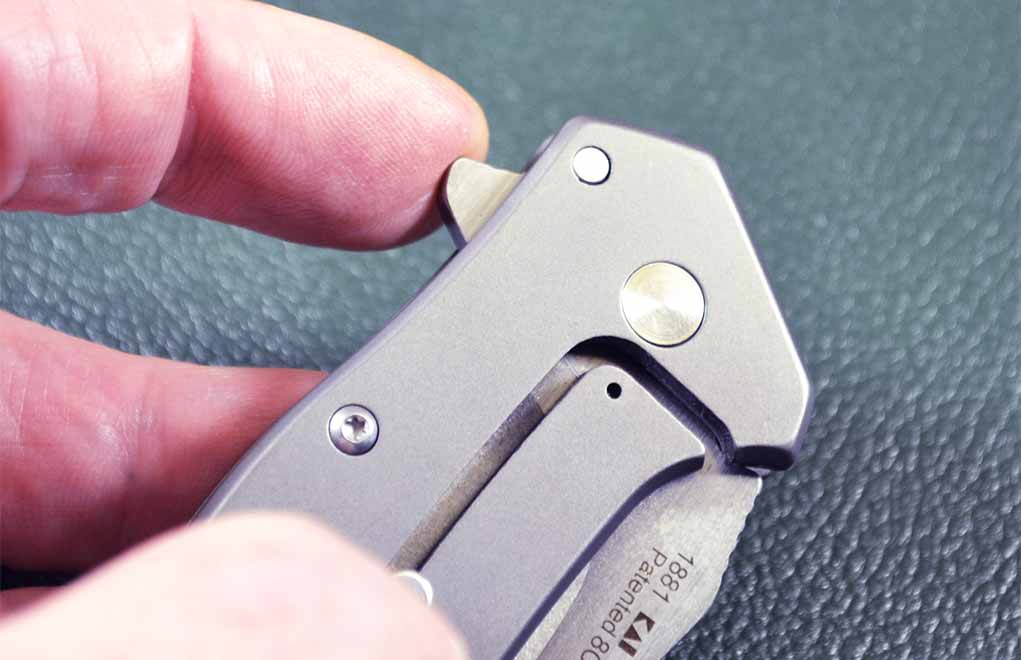
Connelley gives insight into why high-end steels are so much better. “You simply cannot compare a high-alloy particle metallurgy steel blade to a low-grade steel one that is made offshore. You can’t see the difference with your eyes, but a high-quality blade is the cornerstone of a dependable knife.”
The Kershaw Eris’ modified drop-point blade is made of 8Cr13MoV stainless-steel, the Chinese-made version of Japanese AUS-8 steel — a popular low-budget choice by manufacturers. While both are very adequate for budget EDC knives, they don’t hold a candle to the high-end proprietary metals such as the S35VN found on the Reeve Inkosi, and price-wise it isn’t even close.
More EDC Knowledge:
- Perfect Pairs Everyday Carry Knife and Gun Combos
- Gun Review: Is EDC X9 The Best Pistol Ever Made?
- Concealed Carry: What’s The Best Capacity For An EDC Gun?
- Is Everyday Carry (EDC) Really Necessary?
- What You Need To Know To Buy The Best Flashlight
Cost Of Labor
Custom knifemaker Jim Hammond has been making knives for 41 years and has been involved in dozens of design collaborations with Columbia River Knife & Tool (CRKT), dating back to CRKT’s inception in 1994. Hammond is very knowledgeable about the manufacturing end of cutlery production.
“From a manufacturing standpoint, two aspects loom large — ease of fabrication and final product cost,” Hammond notes. “Premium steels can degrade tooling and blanking processes much sooner than lower-quality steels. Too, the factor of seven would often be applied with component costs, such as the steel pricing for each blade. For example, a company’s steel cost per blade would commonly be multiplied by seven to determine its valuation in the final retail pricing of the knife. With a targeted price-point often predetermined going in, the steel selection is often made — not just with the best steel in mind, but the best steel that be used to achieve the targeted retail price point for the knife.”
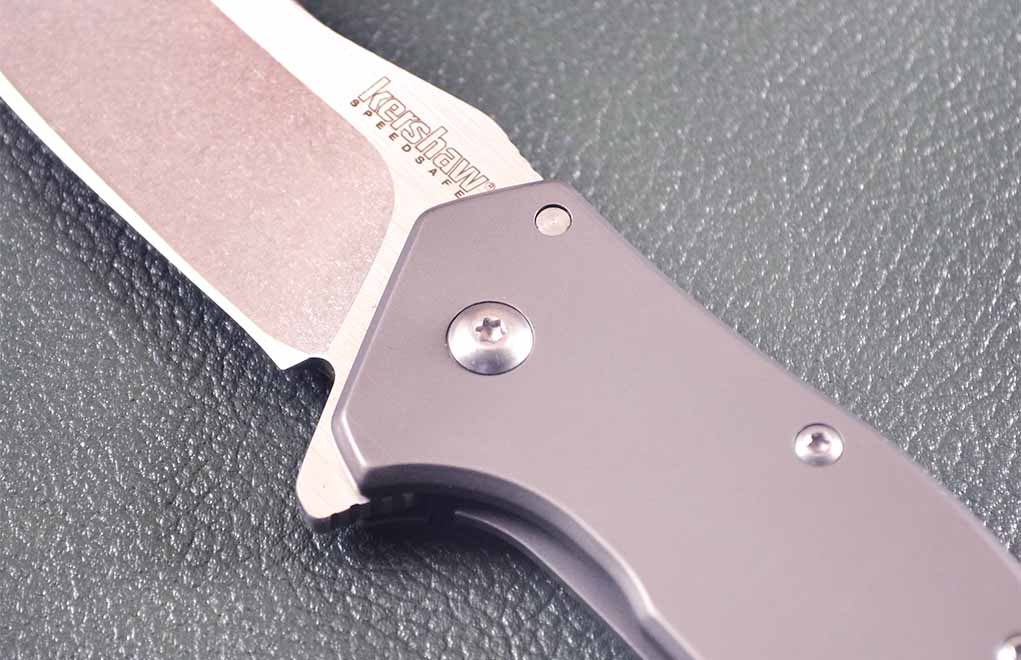
Connelley noted that the cost of a knife is largely determined by the wages in the country in which the manufacturer is based. A recent article by Forbes magazine suggested factory wages in China have increased drastically in the past few years to an average of approximately $3.60 per hour. The average wage of the American factory worker is just north of $21 per hour at the time of this writing, so it’s easy to see the grossly disproportionate amount of labor cost that goes into making a knife in the U.S. versus offshore.
Folding knives require many steps from start to finish, all of which determine the final product. The differences between the equipment used cutting, shaping, sanding and finishing parts for a knife make a difference for the simple reason that some machines hold tolerances better than others. Likewise, the workers running the equipment, inspecting the parts and doing any manual assembly are a factor as well. A manufacturer making thousands of low-budget knives in a single run can’t be expected to have the same quality controls as one making smaller batches of higher-priced ones.
Parts Specification Equation
Parts specifications, such as the thickness of blade steel and frame rails, play a large role in fabrication and determines the efficiency and cost of the folder. For instance, the Reeve Inkosi has a blade thickness of 0.140 inch and 0.1505-inch thick frame slabs. The Kershaw Eris’ blade is 0.11-inch thick and its frame slabs are 0.09-inch thick. A beefier EDC knife will outperform a lesser one but will cost more, which is the case with our subjects. It should also be noted that Integral Locks with thicker frame slabs like the Inkosi’s offer more surface area on the locking leaf, making for a stronger lock-up because more surface area blocks the blade tang.
The quality of manufacture shows up in the crispness of the design and added elements to the whole package. Less expensive knives tend to have rounded contours and flat surfaces on the frame. More expensive knives will have beveling around the slab edges and design enhancements, such as sculpting and inlays (like the Micarta inserts found on the Inkosi). While the overwhelming majority of pocket clips, like those found on the Eris, are stamped stainless-steel, the Inkosi has a titanium one to match the frame.
However, the Kershaw Eris has design features the Reeve knife doesn’t, and these should not be overlooked. The Eris folder opens by way of a blade flipper that protrudes out the top rear of the frame. Many prefer this over the somewhat dated thumb stud because it can be located quicker by the index finger (as opposed to the thumb) and takes only a quick flick to engage the blade. The icing on the Eris’ cake is the addition of Kershaw’s SpeedSafe spring-assisted opening mechanism, which can employ the blade in the blink of an eye — an important feature on any EDC knife for tactical or self-defense use.
Designer Labels
Interestingly, you’ll find a greater selection of collaborations with popular custom knifemakers among the lower-priced knives. While the Kershaw Eris is an in-house design — and a darn good one at that — the company has had great success with custom knifemaker Rick Hinderer’s designs in its standard line and in the more upscale Zero Tolerance line under the same KAI USA Ltd. corporate umbrella.
Collaborations are a huge bonus for the EDC knife customer who can’t afford a custom knife by the same maker. The manufacturers also benefit by increased sales from designer collaborations. How popular are they? In this day and age you’d be hard-pressed to find a cutlery manufacturer who is not offering collaborations with custom knifemakers. Custom knifemakers are also well-served as it gives them added exposure and royalty checks to pad their wallets.
Custom knifemaker Jim Hammond is familiar with such collaborations. “As President Kennedy once said, ‘When the tide comes in, all the ships will rise.’ This has proven true with benefits to everyone in the knife industry with the inflow of custom knifemakers now working with production companies. It’s far easier to utilize creative vision, design understanding and proven manufacturing experience from a maker who’s done it for over 40 years, such as myself, than to train someone for decades to hopefully achieve the same end.”
A Place For Both
Despite such broad differences between low- and high-budget EDC knife options, there is a strong case to be made for each. Budget knives offer a great opportunity for entry-level knife customers to use and enjoy a competent knife at an affordable price, and the selection from the manufacturers is almost endless. Even counting average materials in low-end models compared to high-end knives, budget blades perform perfectly fine for the average user’s everyday needs. And their fixed-blade brethren do well in the field as well. In fact, some knife users carry a budget folder as their EDC knife and switch to a more upscale option for special occasions. Budget knives don’t offer the endurance of high-end knives, but many users will take that trade-off.
High-end folders are for those who prefer the best and can afford to pay the price. They have complete confidence in their knife and know with no uncertainty that it will perform to the extreme, will be less prone to fail and will cut like a house afire with an edge that will hold its sharpness longer.
Better yet, there are a plethora of knives to be had between the low- and high-budget folders featured here. The cutlery market is burgeoning with knives for any budget, any taste and any need. You’ll have no trouble finding a EDC knife made just for you!
Best EDC Knife Picks
Like firearms, EDC choices are measured in the eye of the beholder. Some like them big, some small, and some like them fast. The selection among everyday carries today has never been better and, to help you along, we offer here a group of sizzling slicers in all shapes and sizes geared for making your everyday carry more than just an “everyday” thing.
Olamic Busker Semper

Olamic Cutlery makes some of the coolest folders around, and their Busker Semper model is a favorite among devotees of the brand. The Busker Semper is a small knife — 6 inches overall — with a 2.375-inch Bohler M390 Modified Wharncliffe blade. The handle is constructed of 6AL-4V titanium with an integral lock located on the back of the frame. Other items of note are a caged bearing pivot system, ball ceramic detente, stainless-steel lockbar insert and machined pocket clip with ceramic retention ball. MSRP: $365 and up // OlamicCutlery.com
DPx Urban Ti

Dpx Gear’s Urban line of EDC folders are hot as a firecracker. The DPx HEST/F Urban Ti — 6.7 inches fully extended — is a top-shelf folder featuring a 6AL-4V titanium integral-lock frame with a 2.9-inch blade of premium CPM S35VN stainless-steel. Dpx Gear loaded the Urban Ti up with outstanding features, including a cap lifter, hex drive, wire stripper and glass breaker. A more upscale version, the HEST/F Urban Flipper, is in the pipeline as well and we’ve pictured it here. MSRP: $375 // DPXgear.com
Benchmade Phaeton Auto
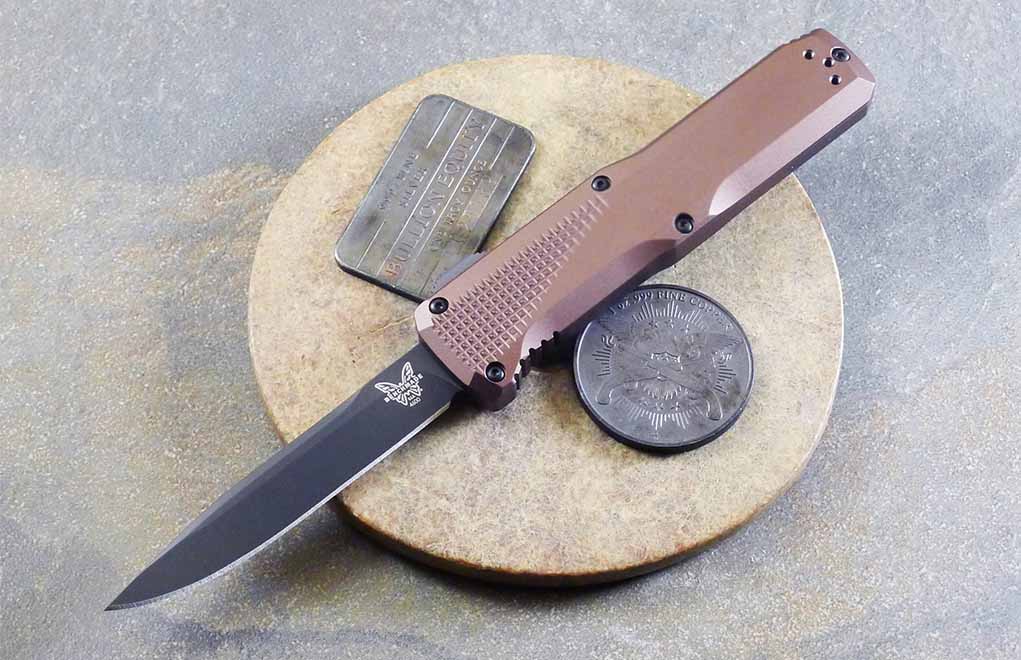
Benchmade Knives has offered automatics for more than 20 years, and recent laws passed across the U.S. are more favorable to these lightening-fast openers. The Benchmade Phaeton model is a slick OTF (Out The Front) auto with all the style and class of a Rolls. Overall length is 8.08 inches — 4.63 inches of that in a partially checkered anodized aluminum handle available in black or dark Earth. The Phaeton’s black-coated dagger-style 3.75-inch CPM S30V stainless-steel clip blade employs and deploys by way of a slide release on the rear spine of the handle. MSRP: $350 // Benchmade.com
Spyderco Shaman

One of Spyderco’s most popular lines is the Native Series, and the Shaman answered the call of those wanting a larger version. In the process they created a beast. The 8-inch overall Shaman features a black G10 handle with ample frame slabs sporting a textured matte finish for enhanced purchase. The Shaman’s 3.58-inch CPM S30V stainless-steel spear-point blade does the cutting chores and opens with ease thanks to the company’s trademark “Spydie hole.” Unlike its smaller Native siblings — which feature liner-locks — the Shaman incorporates Spyderco’s Compression Lock on the upper spine, which is accessible with the knife in-hand. MSRP: $279.95 // Spydero.com
A.G. Russell Wharncliffe
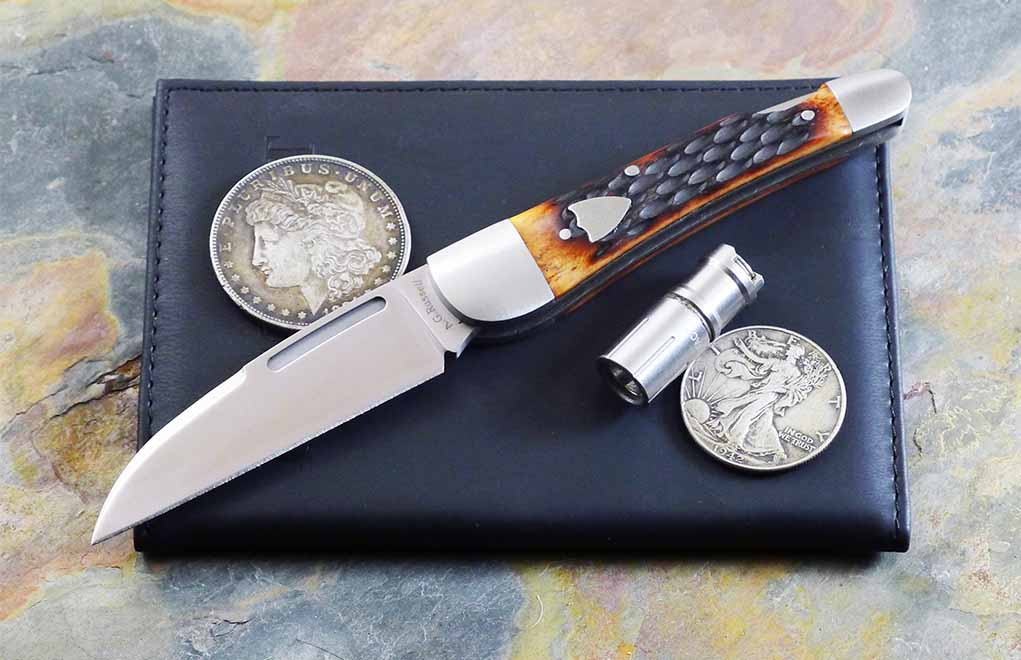
Iconic cutlery entrepreneur/historian A.G. Russell passed away recently. Often overlooked in his pedigree was his tremendous insight into knife design. His Wharnecliffe Lockback, was an instant hit. The Wharnecliffe Lockback is a century-old design modernized by Russell without losing its classic roots. Many still enjoy traditional EDC knife options, and this pocket-folder features an elegantly tapered frame with a hard working 3.25-inch Wharnecliffe 8Cr13MoV stainless-steel blade. In addition, the Wharncliffe Lockback also has 440 stainless-steel bolsters and a modernized lock-back mechanism. The model shown here is done up in brown jigged bone scales, but you can also have it in India stag, white bone and black G10. MSRP: $79.95 // AGrussell.com
Krudo Karsino10

Krudo knives tend to be overbuilt, with added features that are geared toward combat and self-defense. Krudo’s Karsino10 folder has all that in a slick-styled, 8-inch package. The 3.5-inch modified tanto blade of 9Cr8MoV stainless steel rolls out quickly and smoothly on ceramic ball bearings, which are activated by Krudo’s distinctive skeletal flipper tab. A second vertical flipper can be used to thumb open the blade, and a ramped thumb stud adds a third option. In addition, the vertical flipper can also serve as a hitting point when measured restraint is called for in combat. The handle is stainless steel, with a framelock mechanism and carbon-fiber inserts. The whole knife weighs in at 6.1 ounces. The Karsino10 folder carries with the blade tip-up via a beefy, 2.25-inch reversible pocket clip.
The flipper action on the Karsino10 is extremely fast; this is further aided by the fact that it is a large folder. A large folder handle is easier to “grip ’n flip” than a smaller one, because you can spread the three gripping fingers across a bigger footprint and press the handle firmly into the heel of the palm. The top flipper requires a bit more finesse to open using the thumb and takes practice, because it’s not a common method.
I wouldn’t ordinarily use a tanto-style blade for carving wood, but I wanted to try the Karsino10’s brawny blade for strength. As a result, I gave it a go on some basswood. Using the blade’s flat main plain edge, I carved off nice chunks of the material, and the weight of the knife was an added bonus. If you like a big bruiser of a folder, you’ll like this knife. MSRP: $165 // krudoknives.com
Smith’s Battleplan

Well known for its sharpeners, Smith’s joins the flipper fray with the Battleplan. This folder serves up a black, 2.78-inch clip-point blade of stonewashed 420 stainless steel in a flash via a pivot equipped with 416 stainless steel bearings and washers. The 4.4-inch handle is a nicely sculpted G-10 composite that houses a linerlock mechanism between the covers. There’s also an opening option of ambidextrous thumb studs. An ample, 2.5-inch, tip-down, deep-carry pocket clip graces the back side, reversible to the front, and the whole package weighs in at 5 ounces. It measures 7.85 inches fully extended.
The blade rolled out with surprising speed. Here, again, this is a larger knife with an ample grip. The deep-hollow-ground blade is made for slicing, so I gave it a go at some 3/8-inch rappelling rope and super-tough lasso cord. The Battleplan’s business end performed well, tackling both media in single strokes. For a small financial outlay, the Battleplan offers true value for the money. MSRP: $34.99 // smithsproducts.com
Spyderco Hanan
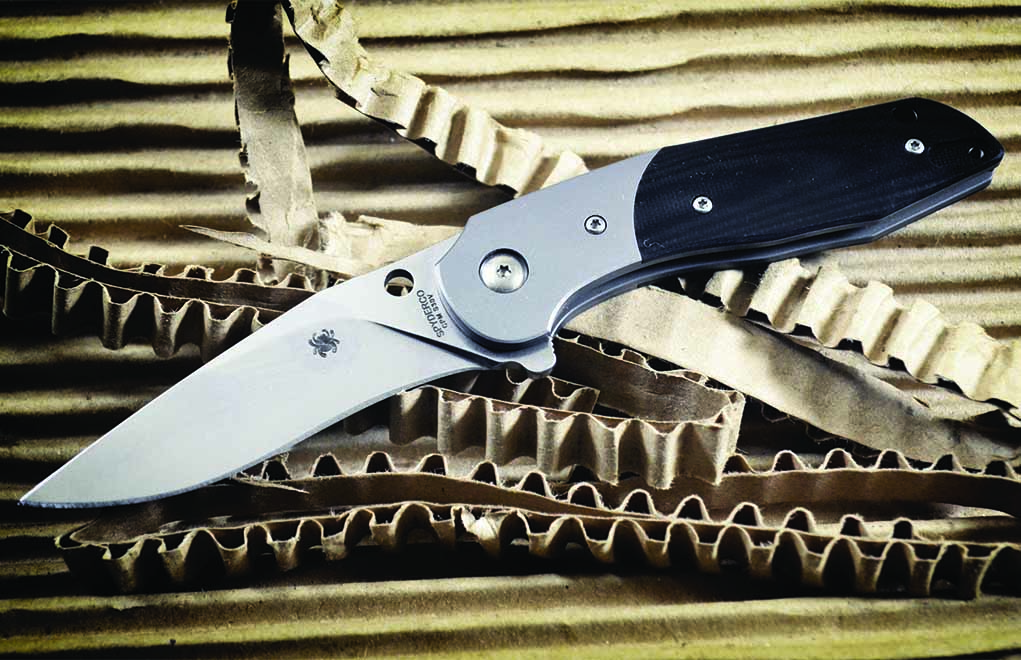
The Spyderco Hanan is the smallest of the group (6.875 inches, open), but it’s stout for its size. Sporting a sweeping recurve blade of CPM S30V stainless steel and a clip point, the Hanan has a phosphor-bronze pivot-bearing cage with large ball bearings. The blade locks up via Spyderco’s patented Compression Lock. The Hanan’s titanium-bolstered frame has black G-10 scales in a curvaceous handle—it’s nothing short of upscale! Out back is a 1.75-inch titanium tip-up pocket clip that can be reversed to the front. The Hanan makes for a lightweight EDC knife, weighing in at a nimble 2.82 ounces.
At 3.875 inches closed, and with a 3-inch blade, the flipper folder falls more into the “gent’s knife” category. Even so, it more than makes up for its size as a result of its tank-like construction. The fit and finish are top shelf—as they should be at this price point. The ball-bearing action is as smooth as silk, and the Compression Lock, which is easily located on the upper part of the spine, snicks and holds the blade like the proverbial bank vault.
The Hanan’s recurve blade glided through some deep, ¼-inch corrugated cardboard quickly and with little pressure. Spyderco blades are some of the sharpest out of the box. The Hanan is true to form. This is a swanky EDC that is up to the task—in spades. MSRP: $360 // spyderco.com
WE Knife Co. Deacon

The WE Knife Co. Deacon, 7.35 inches open, sports a drop-point blade of Bohler M390 stainless steel with a full V-grind. The business half opens by way of a flipper tab only and uses a distinctive, semi-exposed locking liner to secure the blade. A ceramic ball-bearing pivot allows for fast delivery. The handle features purple-anodized titanium bolsters and carbon-fiber scales with blue-accented screws to tie it all together.
The Deacon is nothing short of attractive. Its closed length is 4.1 inches. The drop-point blade rolls out quickly and easily on ceramic ball bearings, and the linerlock mechanism snaps it to attention with authority. MSRP: $298 // weknife.com
I pegged the Deacon’s slender, flat-ground blade as a slicer. It didn’t disappoint, whipping through 1/6-inch-thick suede in clean, single strokes. The handle is thin, but wide, across the midsection, so there’s plenty of comfort. If you’re looking for a lightweight, upscale EDC knife, the Deacon will serve you in style.

Next Step: Get your FREE Printable Target Pack
Enhance your shooting precision with our 62 MOA Targets, perfect for rifles and handguns. Crafted in collaboration with Storm Tactical for accuracy and versatility.
Subscribe to the Gun Digest email newsletter and get your downloadable target pack sent straight to your inbox. Stay updated with the latest firearms info in the industry.

![Best Concealed Carry Guns In 2025 [Field Tested] Wilson Combat EDC X9S 1](https://gundigest.com/wp-content/uploads/Wilson-Combat-EDC-X9S-1-324x160.jpg)


![Best 9mm Carbine: Affordable PCCs [Tested] Ruger Carbine Shooting](https://gundigest.com/wp-content/uploads/Ruger-Carbine-Shooting-100x70.jpg)
![Best AR-15: Top Options Available Today [Field Tested] Harrington and Richardson PSA XM177E2 feature](https://gundigest.com/wp-content/uploads/Harrington-and-Richardson-PSA-XM177E2-feature-100x70.jpg)
